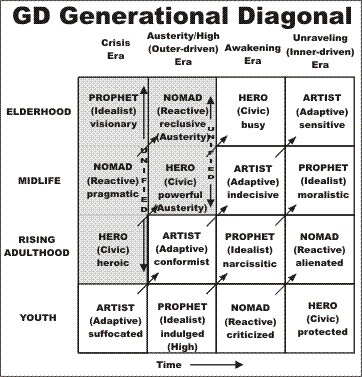Monday, November 10, 2008
Generational Dynamics Summary
I've mentioned GD before (here and here), but happened today upon a very concise summary (in the midst of a largely tangential essay* on macroeconomics):
The historical feedback loop is illustrated by the following "diagonal flow" diagram:

The feedback loop is initially launched by a special kind of war called a "crisis war." These are the worst, most genocidal kinds of wars, when the value of an individual human life becomes so close to zero that almost any means is used to win the war. America has had two such wars since the nation's founding: The Civil War, in which Northern General Sherman marched through the South, and conducted the world's first "scorched earth" war campaign, burning all buildings and crops to the ground; and World War II, in which we firebombed Dresden and Tokyo, killing millions of civilians, and dropped nuclear weapons on two other Japanese cities. (I'm not blaming America for this, only stating that it occurred.)
The Crisis Era launches three following "eras," each approximately 20 years long -- Austerity/High, Awakening and Unraveling. There are four generations of people, designated as Heroes, Artists, Prophets and Nomads, according to the generation in which they're born. Strauss and Howe showed, through study of contemporary diaries and histories of six centuries of Anglo-American history, that people of different generational archetypes are quite dissimilar, but that people in the same archetype, even when they lived centuries apart, are remarkably similar in attitudes towards everything from gender issues to political activism to war.
Briefly, the feedback loop works as follows: the survivors of the crisis war (Civil War, WW II) are so traumatized that they spend the rest of their lives making sure that nothing like that ever happens again. During the period that follows the crisis war, they implement austere rules to guarantee that result. This period is an "Austerity era" to the survivors of the war, but it's a "High era" to those born after the war, the Prophet generation (our Baby Boomer generation), who have no personal memory of the war, and who rebel against the austere rules. This results in a political conflict and a "generation gap" in the Awakening Era (our 1960s-70s), leading to an Unraveling Era (our 1980s-90s), during which all the austere rules completely unravel. After that, the Prophet generation leads the society into a new crisis war.
[emphasis added]